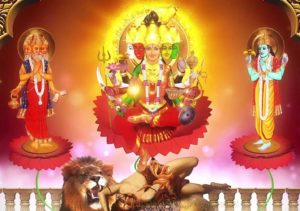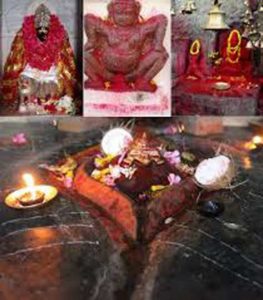Positioned atop the Nilachal Hill in Kamprup district near Guwahati, Assam resides the Kamakhya Devi or the bleeding goddess, Kamakhya means “renowned goddess of desire. This is one of the oldest and most important of the 51 Shakti Peethas. The temple is also known as yoni peetha the deity worshipped here is the yoni of Sati, wife of lord shiva. The Yoni is covered with a red silk sari and spring of river Brahmaputra flows beneath the yoni. Along with the Yoni, the temple complex has individual temples of Dasaha Mahavidyas Kali, Tara, Sodashi, Bhuvaneshwari, Bhairavi, Chhinnamasta, Dhumavati, Bagalamukhi, Matangi and Kamalatmika. Among these, Tripurasundari, Matangi, and Kamala reside inside the main temple whereas the other seven reside in individual temples. It is believed that these Mahavidyas are present here as an incarnation of goddess Kamakhya. The Mahavidyas are non-different from Kamakhya herself.
Kalika Puran mentions Kamakhya as one of four primary shakti peethas: Kalika Purana (the Asthashakti) and various Tantras recognize the four major Shakti Peethas as Adi Shakti Peethas. Like (Bimala, Pada Khanda) inside the Jagannath Temple, Puri, Odisha, (Tara Tarini) Sthana Khanda (Breasts), near Brahmapur, Odisha, (Kamakhya, Yoni khanda) in Guwahati, Assam and (Dakshina Kalika, Mukha khanda) in Kolkata, West Bengal originated from the limbs of the Corpse of Sati. In a hymn, the Kalika Purana (Asthashakti) clearly says:
“Vimala Pada khandancha,
Stana khandancha Tarini (Tara Tarini),
Kamakhya Yoni khandancha,
Mukha khandancha Kalika (Kali)
Anga pratyanga sangena
Vishnu Chakra Kshate nacha……”
Every year during monsoon, the goddess menstruates, and the temple is closed down for three days. It is also when the Tantric fertility festival or Ambubachi Mela is celebrated here, till the fourth day when the temple reopens. It is also said that the underground spring of river Brahmaputra that flows in the sanctum of the temple turns red on these three days. Devotees are offered a piece of the red cloth used to cover the yoni vigrha during the days of menstruation as ‘prasad’.
 Iconography
Iconography
Kamakhya is pictured as a young 16 years old goddess or Sodashi, with twelve arms and six heads of varying colors, representing a powerful goddess who is omnipotent, omniscient and omnipresent. She is wearing opulent jewelry and red flowers of hibiscus. She holds in each of ten hands a lotus, trident, sword, bell, discus, bow, arrows, club or scepter, goad, and shield. Her remaining two hands hold a bowl, which is made either of gold or a skull. She is seated upon a lotus, directly on top of Lord Shiva, who in turn lies atop a lion. To each side of her sit Brahma and Vishnu, who are each seated upon a lotus. Devi Kamakhya’s ‘Ashtashaktis’ or eight associates are Guptakama, Srikama, Vindhyavasini, Kotishvari, Vanadurga, Padadurga, Dirgheshvari, and Bhuvaneshvari.
Legends of Kamakhaya
Kamakhya is also called yoni peetha because Sati’s yoni (vagina) fell here. According to Legend in Devi Bhagavata, Sati’s father Daksha Prajapati held a grand Yagya once, he invited everyone except Shiva and Sati. Daksha found the appearance and lifestyle of Shiva embarrassing. Hearing the news of the Yagya sati insisted ongoing, as a daughter needs no invitation to go to her father’s house. Upon the arrival of Sati, her father insulted her and Lord Shiva. Sati being sinned by hearing the blasphemy of her husband self-immolated in the sacrificial fire. This enraged Shiva and Shiva was seen in most Aggressive and emotional state of mind. He threw locks of hair that caused Bhadra kali and Veera Bhadra to appear. these fearsome and bloodthirsty associates of Shiva were sent to kill everyone present in Daksha’s Yagya. They created havoc and a trial of bloodbath followed. Shiva also appeared there, he lifted the corpse of Sati and was wandering throughout the universe. According to Vedic customs, a body must be destroyed to process the reincarnation. Lord Vishnu using his Sudarshan chakra cut of the body parts of Sati, those cut-off body parts fell on the earth and thus originated Shakti peethas. Kamarupa, formed of desire, is the region in which the yoni is said to have fallen to earth, and the Kamakhya temple was said to have been constructed on this spot. Hence the place is considered as a symbol of women’s power and fertility.
Kamakhya is mentioned in the Kalika Purana as the most important goddess of Tantric worship and is referred to in the text as Mahamaya, the “great goddess of illusion”, who takes on many forms depending on her mood. Devotees also call her Kameshwari (“beloved goddess of desire”), and consider her as an expansion of Maha Tripura Sundari, also called Shodashi. She is identified with Kali in the Kalika Purana, Yogini tantra and Kamakhya Tantra, each of text confirms that Kamakhya is non-different from kali.
Kamakhya finds its name from the Hindu God of love, Kamadeva. according to a legend, that Lord Shiva cursed Kamadeva that he would not be able to enjoy his romantic powers anymore. He was free from his curse after seeking out Sati’s vaginal part at the location of the temple. As a tribute to Shakti and her ability to lend back Kamadeva his potency, the deity of Kamakhya Devi was installed and continues to be worshipped until today.
Narakasur was a demon with great might, lord shiva had given him five boons and his mother Bhudevi had promised him a long reign on earth. Just as all demons do Naraka also conquered all the kingdoms of earth along with the Indra’s heaven. He had also abducted 16,000 princesses belonging to various kingdoms. According to a popular narrative, Narakasur was killed by Lord Krishna. But according to folklore or sthala Purana, he was killed by Devi Kamakhya.
Once Narakasura, motivated by his desire, wanted to marry Kamakhya, When proposed, the Goddess playfully put a condition before him that if he would be able to build a staircase from the bottom of the Nilachal Hill to the temple within one night before the cock crows to indicate Dawn, then she would surely marry him. Naraka took it as a challenge and tried all with his might to do this huge task. He was almost about to accomplish the job before it was dawn. When Kamakhya Devi got this news, she playfully strangled a cock and made it crow untimely to give the impression of Dawn to Naraka. Duped by the trick even Naraka thought that it was a futile job and left it halfway through.
Devi Kamakhya appeared in Narakasur’s lair in her glorious form. Kamakhya empowers all the 16,000 women present there to fight Narakasur’s demon army. Meanwhile, Narakasur is fallen to the ground by Kamakhya Devi. Kamakhya then enumerates the five boons that Lord Shiva had given and the last one being that he will die only when he calls upon his death.
Kamakhya Devi tells him that she is none other than the Supreme Goddess Mahakaali, who is the creator, preserver, and destroyer of all. Narakasur sees the horrific Goddess Mahakali, standing in full view, in his front. Upon seeing Kamakhya as Mahakaali, Narakasur was scared. The demon begs Goddess Kamakhya for a death that would make him remembered as a devotee and not a demon. Kamakhya grants the same. Kamakhya kills Narakasur with her trident and frees all the 16,000 women.
 Yoni symbolism
Yoni symbolism
Yoni has a special symbolic significance; it is believed to be the source of creation and epicenter of the ultimate creation. The creation cannot happen with the union of Shakti and Shaktiman, the energy and implementation of energy. The Asian concept of Yin and Yang is the counterpart of this phenomenon. There is no Shiva without Shakti, Shiva being the supreme being is incomplete without Shakti. It is only through the transcendental union of the Linga with yoni the creation comes into being. The Shiva Linga is, therefore, the ultimate symbol of power as it is situated on top of the yoni. Yoni is the ultimate manifestation of the primordial Shakti. The Yoni tantra eulogizes the worship and sadhana of the yoni as ultimate sadhana.
Temple rituals
A very special form of Sindoor, available here, made from rock and called Kamakhya Sindoor, which is believed to be a blessing bestowed by Kamakhya Devi herself, to the wearer
The Yogini Tantra mentions that the religion of the Yogini Pitha is of Kirata origin. According to Banikanta Kakati, there existed a tradition among the priests established by Nara-Narayana that the Garos, a matrilineal people, offered worship at the earlier Kamakhya site by sacrificing pigs. Shakti worship is always connected with animal sacrifice, therefore many Animal sacrifices take place during these pujas such as goat, pigeon, buffalo, etc. The sacrifice of a female animal is strictly prohibited in this temple complex.
The goddess is worshiped according to both the Vamachara (Left-Hand Path) as well as the Dakshinachara (Right-Hand Path) modes of worship, most of Kaul tantras originated from Kamrupa. It is believed that for a tantric to be completely powerful, he must pay a visit to Kamakhya and pay his offerings and prayers to the goddess Kamakhya. One will find many Aghori sadhus in and around the temple complex. There are pujas done to free people of suffering from black magic, dark spirits, and ghosts. The tantric here can also help people with various problems of life be it relationship, prosperity, and diseases.
